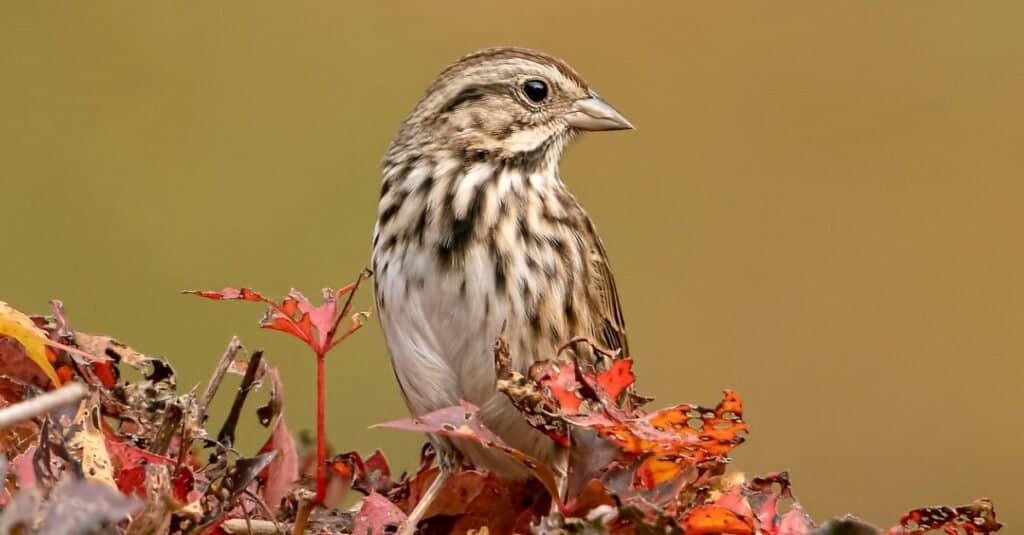Song Sparrow
Melospiza melodia
Pumps its tail when it flies!
Advertisement
Song Sparrow Scientific Classification
- Kingdom
- Animalia
- Phylum
- Chordata
- Class
- Aves
- Order
- Passeriformes
- Family
- Passerelidae
- Genus
- Melospiza
- Scientific Name
- Melospiza melodia
Read our Complete Guide to Classification of Animals.
Song Sparrow Conservation Status
Song Sparrow Facts
- Prey
- Insects
- Name Of Young
- Nestling, fledgling
- Group Behavior
- Solitary
- Fun Fact
- Pumps its tail when it flies!
- Estimated Population Size
- Over 100 million
- Biggest Threat
- Habitat loss
- Most Distinctive Feature
- Distinctive brown and gray stripes
- Other Name(s)
- Song sparrow
- Gestation Period
- 12 to 14 days
- Litter Size
- 3-6
- Habitat
- Shrubs, gardens, woodlands
- Predators
- Owls, hawks, cats
- Diet
- Omnivore
- Type
- Sparrow
- Location
- North America
Song Sparrow Physical Characteristics
- Color
- Brown
- Grey
- White
- Chestnut
- Skin Type
- Feathers
- Top Speed
- 30 mph
- Lifespan
- 4 to 5 years
- Weight
- 0.4 to 1.9 ounces
- Height
- 3 inches
- Length
- 4.7 to 7 inches
- Age of Sexual Maturity
- 1 year
- Age of Weaning
- 10 to 12 days
View all of the Song Sparrow images!
The song sparrow is one of the most common birds in North America. As its name says, this bird is known for its lovely call. It is a pretty bird with chestnut brown and soft gray stripes. You are likely to see this bird in wooded areas and suburban gardens.
5 Incredible Song Sparrow Facts!
- This bird changes it appearance according to where it lives.
- It pumps its tail while it’s flying.
- Song sparrows get their name from their beautiful singing.
- Brown-headed cowbirds sometimes lay their eggs in song sparrow nests.
- It is an excellent insect catcher.
Song Sparrow Scientific Name
Its scientific name is Melospiza melodia.
Song Sparrow Appearance
This bird is a medium-sized, slightly stocky sparrow. It stands from 5 to 7 inches tall and weighs under 2 ounces. Its wingspan varies from 7 to 9.4 inches. It has a classic sparrow shape with a small, pointed beak and a long tailfeather. Male and female song sparrows are the same size.
Identification is easy because of this bird’s distinctive stripes. Most song sparrows have bright, clear stripes of chestnut brown, soft gray, and white.
However, this bird’s appearance varies greatly depending on where it lives. Birds in coastal areas and the northern Aleutians, for instance, are larger and darker in color. Birds in southern regions are paler, and those in desert regions are pale gray.
There are 24 species of the sparrow. They vary slightly in appearance and geographic distribution.
Here are some birds that may be mistaken for song sparrows, with tips for identification.
- White crowned sparrow: This bird has brown and gray stripes, but it is not as distinctly striped as the song sparrow. The white crowned sparrow has a striped, black and white cap that almost looks like a skunk stripe.
- White throated sparrow: This large, plump sparrow has striped wings, a black cap and a distinct yellow spot between the eye and the bill. True to its name, the white throated sparrow has a bright white patch on its throat.
- Golden-crowned sparrow: The golden-crowned sparrow is a slightly stocky, small sparrow. This bird has a black cap with a bright yellow stripe on it.

Song sparrow resting on an autumn morning with a blurred background.
©iStock.com/Luc Pouliot
Song Sparrow Behavior
This bird likes to hide in dense, low vegetation, but you will see it make short, fluttering flights from branch to branch. It is known for the way it “pumps” its tail downward while in flight. Male song sparrows are exceptionally melodious, and they will fly to open branches or perches to sing.
The male’s song sounds like it’s singing “sweet, sweet, sweet” followed by a “tow-wee” call and a trill. Unlike many birds, it sings all year. Young males develop unique songs which they learn from older birds in their territory. This causes song sparrows to have regional differences—almost like accents—in their singing.
Song Sparrow Habitat
The song sparrow is widespread in North America and lives in a wide diversity of habitats. This bird can be found in thickets, brush, shrubby marsh edges, woodland edges, forests, and hedgerows. Song sparrows live in salt marshes, deserts, and the Aleutian Islands.
Most song sparrows do not migrate. Those that live in cold northern regions will migrate south to warmer parts of the U.S. or northern Mexico.
Song Sparrow Diet
The song sparrow forages on the ground, and it may scratch the soil to find its favorite foods. It mostly eats insects and seeds. It eats a wide variety of insects, including beetles, grasshoppers, wasps, spiders, and ants.
Like most animals with a widespread distribution, their food depends largely on their surrounding habitat. Song sparrows in coastal and island regions, for instance, also eat small crustaceans and mollusks. Seeds are another important part of this bird’s diet.
Song Sparrow Predators and Threats
This bird’s chief predators are hawks, owls, and cats.
Besides these predators, brown-headed cowbirds sometimes lay their eggs in song sparrow nests.
Females sometimes attack female cowbirds to chase them from their nests. Despite this protective behavior, many song sparrows end up inadvertently raising cowbird babies along with their own baby sparrows. Some researchers believe that cowbirds look for these “aggressive” females, thinking that their aggressiveness means they will be good mothers for their cowbird babies.
Song Sparrow Reproduction and Life Cycle
A male sparrow shows his interest in a female by performing a “courtship dance” of fluttering with his neck stretched out. This mating behavior coupled with its singing is how the male attracts a female.
After mating with a male sparrow, the female builds a nest, usually on the ground under a clump of grass or shrubbery. The male may help gather materials for the nest, but the female builds it. She builds the nest from weeds, leaves, strips of bark, and animal hair. After a short gestation, she lays four to six eggs. The eggs are pale green and speckled. She sits on the eggs to incubate them for up to 14 days.
Both parents feed the baby birds. After about 10 days, the baby birds are ready to leave the nest and begin learning to forage for themselves. They stay with their parents for about 3 weeks.
Song sparrows return to the same spot every year to nest.
Song Sparrow Population
There are more than 100 million song sparrows in the U.S. It is one of the most populous birds in North America.
Conservation Status
Song sparrows are listed as “least concern” by the International Union for the Conservation of Nature (IUCN). Like many songbirds, however, they are threatened by climate change and habitat loss.
Enjoy Song Sparrows All Year
Song sparrows fill our woodlands and gardens with their beautiful singing. Because they usually don’t migrate, you can enjoy them all year long.
View all 293 animals that start with SSong Sparrow FAQs (Frequently Asked Questions)
What does a song sparrow sound like?
Its main song sounds like it is singing, “sweet, sweet, sweet” followed by a long call of “too-wee” and a running trill. Most song sparrows sing a variation of this tune.
What does a song sparrow eat?
It mostly eats insects and seeds.
How long until song sparrow babies fly?
It takes about a month after they’re born before they are ready to fly.
Why is it called a song sparrow?
It gets its name from its beautiful song and the fact that it sings all year. Some birds only sing in winter, fall and spring.
Are song sparrows aggressive?
They are not typically aggressive, but females may attack female cowbirds who get close to their nests.
Do song sparrows sing in winter?
Yes, they sing all year.
How common are song sparrows?
They are one of the most common birds in North America. Many sparrow species look alike, especially from a distance. People confuse the song sparrow with the house sparrow, white-crowned sparrow, and white-throated sparrow. The best way to be sure of your identification is to look for the song sparrow’s distinctive stripes and downward-pumping tail.
Where do song sparrows nest?
They prefer to nest on the ground or close to it. They like to build nests in prickly shrubs or between thick clumps of grass. Rose bushes are a favorite nesting spot for song sparrows because the thorns protect them from predators. These birds are a welcome sight to gardeners who appreciate their excellent bug-killing behavior.
What are the differences between a song sparrow and a house sparrow?
Song sparrow vs. house sparrow – the song sparrow is insectivorous, nests in shrubs, and is a ground forager. The house sparrow is omnivorous, nests in cavities, and is also a ground forager.
Thank you for reading! Have some feedback for us? Contact the AZ Animals editorial team.
Sources
- Audubon, Available here: https://www.audubon.org/field-guide/bird/song-sparrow
- All About Birds, Available here: https://www.allaboutbirds.org/guide/Song_Sparrow/id#
- James M. Smith et. al, Age, Experience and Enemy Recognition by Wild Song Sparrows, Available here: https://link.springer.com/article/10.1007/BF00291901

















